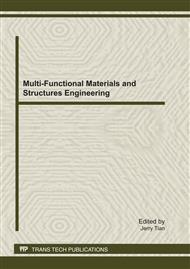p.36
p.41
p.48
p.53
p.59
p.65
p.73
p.79
p.84
A Friction Damper with Continuously Variable Post-Sliding Stiffness
Abstract:
Proposed in this study is a type of friction damper characterized a continuously variable post-sliding stiffness, which provides an increasing post-sliding force with the accretion of the deformation. It is possible to adjust the output force according to the performance targets at different earthquake levels, thus enlightening a practical approach to the explicit structure control to satisfy all of the required performance objectives. The proposed damper consists of a piston, a rubber layer, friction plates and the jacket. The friction plates and the inside of the jacket constitute the contact pair, or the sliding surface. The friction plates are fixed on the piston through the rubber layer which provides the normal pressure on the sliding surface. The radius of sliding surface varies continuously along the axis of the jacket. Both analyses and experiments reveal that the parabola shape of sliding surface would introduce a cubic force-displacement relationship, thus being helpful to prevent a structure from collapse.
Info:
Periodical:
Pages:
59-64
Citation:
Online since:
July 2011
Price:
Сopyright:
© 2011 Trans Tech Publications Ltd. All Rights Reserved
Share:
Citation:


